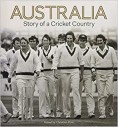Crossing the Line: How Australian Cricket Lost its Way
Jon Gemmell |Published: 2018
Pages: 176
Author: Haigh, Gideon
Publisher: Slattery Media Group
Rating: 4 stars

Most works of significant events use their opening chapter to set their subject in its context. With this in mind, don’t be expecting here a book on what has been called ‘sandpapergate’, for Haigh uses the first six (of seven) chapters to provide the background to what happened. In fact, this book is more to do with the Australian administration and attitudes to the spirit of cricket and in particular what is called ‘the line’ of acceptability.
The prolific author has also published on the topic of business and he uses the injection of commercial initiatives as a starting place. It was argued in 2010 that cricket was losing popularity and that it no longer reflected the interests and tastes of the wider community. The answer to rejuvenate the sport was the twenty overs format. A new strategic plan was to be headed by former National Bank boss Don Argus. He brought in consultants with a business background to survey the cultural aspects of the team. They produced a survey that asked questions such as ‘are you tapping into people’s discretionary effort?’ The Argus Review asserted further corporate gobbledegook onto the captain and coach who were responsible for creating a ‘high performance culture’, embracing ‘best practice transfer’ and a ‘360-degree feedback process.’
Former rugby player Pat Howard became responsible for team performance. He eschewed traditional methods for selection preferring an analysis on data performance.
The coach Darren Lehman initially claimed to be shocked by the antics of his players involved in using sandpaper to rough up the cricket ball. Yet, Haigh cites numerous examples of him laying out the standards that led to this vandalism. On taking up his role Lehman promised that his team would play a certain aggressive form of cricket. The word aggression features in a number of his talks, presentations and writings. This led some to say that the line was attributed to ‘Boof’. He particularly identified with David Warner: ‘he plays the game in exactly the way I want.’
The idea of a spirit of cricket was supposedly very important to Australian cricket. Captain Michael Clarke had stated in 2013 that ‘if you play for Australia, there is a lot that comes with that, and standards, discipline, culture are all a big part of what we’re talking about.’ Following the incident at Cape Town, captain Steve Smith confessed at a rashly called press conference that ‘it’s not what we want to see in the game, it’s not what the Australian cricket team’s about.’
Yet Haigh unpicks evidence to suggest otherwise. When Clarke told England’s James Anderson to prepare for a broken arm in December 2013, the commentator Shane Warne proclaimed that his friend had come of age and would be accepted as a hero. Warner seemed to personify a type of cricket that constantly pushed the boundaries. This was evident in accusing Jonathan Trott of having ‘scared eyes’, of seeing the Ashes as ‘war’ and the South Africans of adopting ‘sharp practice.’
There are further illiustrations in the book of players mixing the terms aggression and not crossing the line. For Nathan Lyon: ‘we know where the line is. We headbutt it, but we don’t go over it.’ Warner, though, comes closest to admitting that sometimes you have to cross the line in order to win.
At first, Smith denied that he would be standing down as captain, but alongside the coach, Cricket Australia also parted ways with its chief executive, a director, a legal officer and the public affairs manager. Individuals and institutions were abandoned by sponsors and one only wonders at the effect on supporters.
Haigh argues convincingly that this was no one-off occasion, rather the culmination of a number of complaints and disregards about the way the sport was played. There was a sense that the public was waiting for an incident around which they could express their dissatisfaction. The prime Minister stepped in twice and demanded action. Now the ‘Australian Way’ was un-Australian.
As always, when reading Haigh, you sense he is attempting to educate you. I don’t think I’ve seen the words deciduous, fiduciary, briar, flexion or expiation (there are more) in any other cricket book; nor that the act of sandpapering a cricket ball was as crass as Boris Onischenko’s épée.
The author signs off with a sad indictment of a sport highjacked by ‘a commercial and bureaucratic elite puffed up with its own importance.’ In South Africa three players had a lack of judgement, pushed up to the line, they stumbled across it and cricket sought to hide that these were just three bad boys. This book exposes the wider guilt and is highly recommended.






Leave a comment